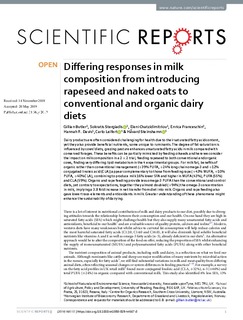| dc.contributor.author | Butler, Gillian | |
| dc.contributor.author | Stergiadis, Sokratis | |
| dc.contributor.author | Chatzidimitriou, Eleni | |
| dc.contributor.author | Franceschin, Enrica | |
| dc.contributor.author | Davis, Hannah R. | |
| dc.contributor.author | Leifert, Carlo | |
| dc.contributor.author | Steinshamn, Håvard | |
| dc.date.accessioned | 2019-06-18T12:42:38Z | |
| dc.date.available | 2019-06-18T12:42:38Z | |
| dc.date.created | 2019-06-14T10:27:25Z | |
| dc.date.issued | 2019-05-31 | |
| dc.identifier.citation | Scientific Reports. 2019, 9 . | nb_NO |
| dc.identifier.issn | 2045-2322 | |
| dc.identifier.uri | http://hdl.handle.net/11250/2601221 | |
| dc.description.abstract | Dairy products are often considered challenging for health due to their saturated fatty acid content, yet they also provide beneficial nutrients, some unique to ruminants. The degree of fat saturation is influenced by cows’ diets; grazing pasture enhances unsaturated fatty acids in milk compared with conserved forages. These benefits can be partially mimicked by feeding oilseeds and here we consider the impact on milk composition in a 2 × 2 trial, feeding rapeseed to both conventional and organic cows, finding very differing lipid metabolism in the 4 experimental groups. For milk fat, benefits of organic rather than conventional management (+39% PUFA, +24% long chain omega-3 and +12% conjugated linoleic acid (CLA)) appear complementary to those from feeding rape (+43% MUFA, +10% PUFA, +40% CLA), combining to produce milk 16% lower SFA and higher in MUFA (43%), PUFA (55%) and CLA (59%). Organic and rape feeding provide less omega-3 PUFA than the conventional and control diets, yet contrary to expectations, together they almost doubled (+94%) the omega-3 concentration in milk, implying a 3.8 fold increase in net transfer from diet into milk. Organic and rape feeding also gave lower trace-elements and antioxidants in milk. Greater understanding of these phenomena might enhance the sustainability of dairying. | nb_NO |
| dc.language.iso | eng | nb_NO |
| dc.rights | Navngivelse 4.0 Internasjonal | * |
| dc.rights.uri | http://creativecommons.org/licenses/by/4.0/deed.no | * |
| dc.subject | Milk composition | nb_NO |
| dc.subject | Organic dairy diets | nb_NO |
| dc.subject | Rapeseed | nb_NO |
| dc.subject | Naked oats | nb_NO |
| dc.title | Differing responses in milk composition from introducing rapeseed and naked oats to conventional and organic dairy diets | nb_NO |
| dc.type | Journal article | nb_NO |
| dc.type | Peer reviewed | nb_NO |
| dc.description.version | publishedVersion | nb_NO |
| dc.rights.holder | © The Author(s) 2019 | nb_NO |
| dc.subject.nsi | VDP::Landbruks- og Fiskerifag: 900 | nb_NO |
| dc.source.pagenumber | 12 | nb_NO |
| dc.source.volume | 9 | nb_NO |
| dc.source.journal | Scientific Reports | nb_NO |
| dc.identifier.doi | 10.1038/s41598-019-44567-8 | |
| dc.identifier.cristin | 1704881 | |
| dc.relation.project | EC/FP7/222623 | nb_NO |
| cristin.unitcode | 7677,1,0,0 | |
| cristin.unitname | Divisjon for matproduksjon og samfunn | |
| cristin.ispublished | true | |
| cristin.fulltext | original | |
| cristin.qualitycode | 1 | |

